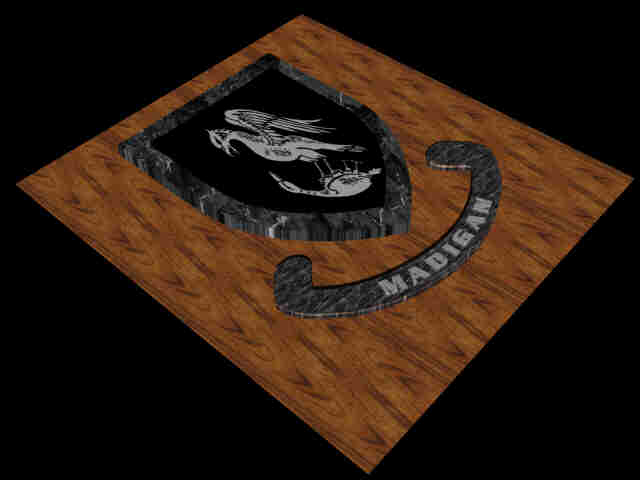The powder works
depended mainly on waterpower during 120 years of operation.
Until the coming of steam power, industrial operations were
largely confined to the banks of the Brandywine. With the
installation of steam engines in the 1850s other areas of the
property were opened to mill construction. The roller mills were
actually small one room buildings with three substantially
reinforced outer walls and a forth wall facing the river with was
quite flimsy in construction. In addition, a light sheet metal
roof was designed to
works
depended mainly on waterpower during 120 years of operation.
Until the coming of steam power, industrial operations were
largely confined to the banks of the Brandywine. With the
installation of steam engines in the 1850s other areas of the
property were opened to mill construction. The roller mills were
actually small one room buildings with three substantially
reinforced outer walls and a forth wall facing the river with was
quite flimsy in construction. In addition, a light sheet metal
roof was designed to 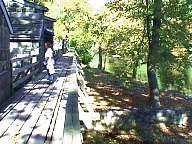 blow out over the creek in case of explosion,
thereby venting the blast and reducing the damage. Although the
danger was greatly reduced, explosion was a constant possibility
and infrequently did occur. The process was simple. There was a
wooden railed trestle running to each of the mills. The
ingredients were brought to the roller mills on the tracks by way
of a hand cart. The ingredients, in proper proportions were
spread out evenly on the floor. As we worked our way down the
boardwalk of the old trestle of the Old Eagle Roll
blow out over the creek in case of explosion,
thereby venting the blast and reducing the damage. Although the
danger was greatly reduced, explosion was a constant possibility
and infrequently did occur. The process was simple. There was a
wooden railed trestle running to each of the mills. The
ingredients were brought to the roller mills on the tracks by way
of a hand cart. The ingredients, in proper proportions were
spread out evenly on the floor. As we worked our way down the
boardwalk of the old trestle of the Old Eagle Roll 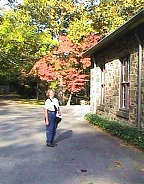 Mill, we
could see the pair of roll mills, which were built in 1839 to
produce Eagle brand sporting powder. In 1886, an iron water
turbine replaced the original wooden water wheel that powered the
mills. Rolling was the first step in the powder making process.
In this step the ingredients were mixed together, or "incorporated" with water under two revolving eight-ton
cast-iron wheels. After rolling, the damp powder, called
"wheelcake" was shoveled into tubes and transported to
the press house. Workers left the building before the rollers
were put in motion. They kept track of the progress through peep
holes. It was unsafe to be within the blast area should an
accident occur. In most cases mills were built in pairs.
Mill, we
could see the pair of roll mills, which were built in 1839 to
produce Eagle brand sporting powder. In 1886, an iron water
turbine replaced the original wooden water wheel that powered the
mills. Rolling was the first step in the powder making process.
In this step the ingredients were mixed together, or "incorporated" with water under two revolving eight-ton
cast-iron wheels. After rolling, the damp powder, called
"wheelcake" was shoveled into tubes and transported to
the press house. Workers left the building before the rollers
were put in motion. They kept track of the progress through peep
holes. It was unsafe to be within the blast area should an
accident occur. In most cases mills were built in pairs.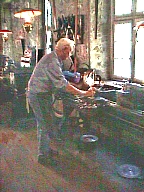 When one went up in smoke, the other was available to continue
producing the particular powder assigned to that mill. In the mid
1800s, there were no places to buy the machines which du Pont
needed to perfect his new process so he constructed a machine
shop. By those standards, it was one of the best in the area.
Here craftsmen would build the ironworks needed in the mills. The
old machine shop has been recreated with many of the original time
period machines. The power was again a water wheel from a race box
alongside the building. This wheel turned a continuous wide
leather belt which traveled around the building near the ceiling.
Additional wheels would be pressed against the belt where needed
in order to drive the various laths, grinders and drills.
Although they moved
When one went up in smoke, the other was available to continue
producing the particular powder assigned to that mill. In the mid
1800s, there were no places to buy the machines which du Pont
needed to perfect his new process so he constructed a machine
shop. By those standards, it was one of the best in the area.
Here craftsmen would build the ironworks needed in the mills. The
old machine shop has been recreated with many of the original time
period machines. The power was again a water wheel from a race box
alongside the building. This wheel turned a continuous wide
leather belt which traveled around the building near the ceiling.
Additional wheels would be pressed against the belt where needed
in order to drive the various laths, grinders and drills.
Although they moved 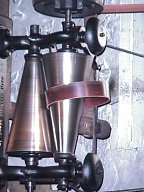 slower then one would probably see in a modern
day machine shop, they did a nice job of cutting and grinding. One
of the many problems that de Pont had to overcome was the one
speed belt, which was driving many different machines at the same
time. These machines needed to run at different speeds to be most
efficient. An ingenious device was added to the linkage between
the machine drive belt and the overhead belt. It was two steel
cones one inverted beside the other. A belt was placed between
the two cones. The speed of the machine could be altered by
sliding the belt up and down, effectively changing the diameter
of the gear. It was quite something to see the thing in action.
So simple yet so effective. In the new world of electronics and
computer design, I don't get to see the neat devices that make
all of the work come together as it was in the olden days. Du
Pont's mansion is located on the property but I had dawdled
along, fascinated with the mechanics of gunpowder and had let the
day slip away. By the time we had finished watching the
demonstrations at the machine shop it was closing time and we had
to leave. Still the day had been beautiful and the fall colors
brilliant. All in all a day I thoroughly enjoyed.
slower then one would probably see in a modern
day machine shop, they did a nice job of cutting and grinding. One
of the many problems that de Pont had to overcome was the one
speed belt, which was driving many different machines at the same
time. These machines needed to run at different speeds to be most
efficient. An ingenious device was added to the linkage between
the machine drive belt and the overhead belt. It was two steel
cones one inverted beside the other. A belt was placed between
the two cones. The speed of the machine could be altered by
sliding the belt up and down, effectively changing the diameter
of the gear. It was quite something to see the thing in action.
So simple yet so effective. In the new world of electronics and
computer design, I don't get to see the neat devices that make
all of the work come together as it was in the olden days. Du
Pont's mansion is located on the property but I had dawdled
along, fascinated with the mechanics of gunpowder and had let the
day slip away. By the time we had finished watching the
demonstrations at the machine shop it was closing time and we had
to leave. Still the day had been beautiful and the fall colors
brilliant. All in all a day I thoroughly enjoyed.
For more information
about this exciting adventure log on to
www.hagley.org
***THE END***

